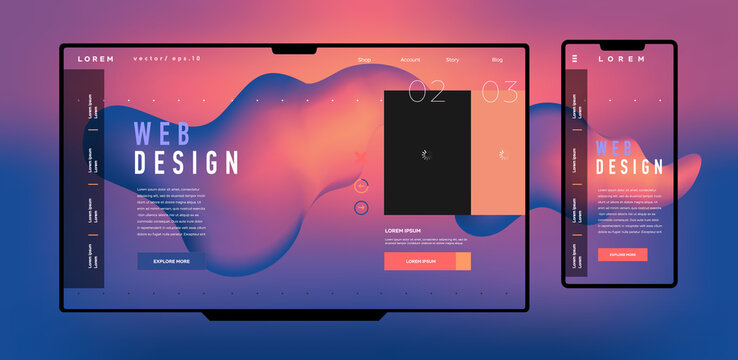The Vital Aspects of Efficient Internet Design: A Comprehensive Guide
Efficient web Design incorporates different critical elements that significantly effect customer experience. It requires cautious consideration of variables such as mobile responsiveness, intuitive navigation, and visual power structure. Each component plays a necessary role in crafting a web site that not only brings in visitors however also keeps them. Comprehending these foundational elements is crucial for services intending to boost their online presence. What truly distinguishes an effective site from its competitors?
Understanding Customer Experience (UX) Design
User experience (UX) Design functions as the foundation of efficient website design, concentrating on exactly how customers interact with a website. It incorporates numerous elements, consisting of functionality, access, and total contentment. An effective UX Design starts with user research study, determining the target audience's actions and requirements. Models and wireframes are after that established to envision the web site's framework and circulation. Web Design South Africa. Testing with actual individuals gives important understandings, permitting designers to refine the interface and boost navigating. Visual Design elements, such as typography and color plans, boost the total visual while supporting capability. Eventually, efficient UX Design guarantees that users can conveniently complete their goals, promoting interaction and commitment. By focusing on customer experience, web sites can accomplish higher conversion rates and a positive online reputation
Importance of Mobile Responsiveness
As smart phones increasingly dominate net use, making certain mobile responsiveness has come to be essential for efficient internet Design. Web sites that are not optimized for mobile can result in a poor individual experience, resulting in higher bounce prices and shed chances. A mobile-responsive Design permits content to adjust seamlessly to different display dimensions, making certain that customers can access info conveniently, no matter of the gadget they use. Furthermore, online search engine focus on mobile-friendly websites in their rankings, making responsiveness an important element for visibility and traffic. With an expanding number of customers accessing the internet through tablet computers and smart devices, organizations must spend in mobile responsiveness to improve customer interaction, improve brand perception, and eventually drive conversions. Reliable internet Design have to prioritize mobile responsiveness to remain competitive in today's electronic landscape.
Crafting User-friendly Navigation
Navigating works as the backbone of any reliable website, directing visitors with content easily. An intuitive navigation framework enhances individual experience by permitting customers to discover information quickly and efficiently. Clear labeling of menu items is crucial; it needs to mirror the content accurately, staying clear of jargon that may confuse individuals. Furthermore, a sensible hierarchy is important, allowing individuals to recognize connections between various areas. Consistency across web pages assists enhance expectations, while breadcrumbs supply context and an orientation. Receptive navigating food selections that adjust to various devices even more enhance ease of access. Inevitably, the goal is to produce a smooth journey for visitors, ensuring they can explore the site without disappointment, resulting in an extra engaged and pleased audience.
Using Aesthetic Pecking Order
Visual pecking order plays a critical role in website design by assisting users' attention and boosting their experience. Reliable format strategies, together with thoughtful choices in color and typography, can greatly influence exactly how details is regarded and processed. Comprehending these aspects is important for producing visually enticing and practical web sites.
Relevance of Visual Pecking Order
Effective website design hinges on the principle of aesthetic hierarchy, which guides users with web content in a intuitive and logical fashion. This concept is crucial for improving user experience, as it helps prioritize details and directs attention to important aspects. By establishing a clear power structure, web developers can ensure that individuals conveniently identify essential messages, phones call to action, and navigating options. A well-structured aesthetic pecking order decreases cognitive tons, enabling individuals to refine details efficiently. Furthermore, it promotes interaction by producing an appealing layout that invites expedition. Eventually, understanding the value of visual hierarchy is vital for any kind of web developer aiming to produce effective and easy to use web sites that successfully interact their desired messages.

Methods for Reliable Layout
An efficient format works as the backbone of any kind of successful web Design, permitting customers to effortlessly navigate through material. Effective strategies include grid systems, which supply an organized structure for straightening aspects, guaranteeing uniformity and balance. Additionally, using whitespace purposefully can improve concentrate on essential areas, lowering aesthetic mess and directing customer attention. Focusing on material through dimension and placement additionally emphasizes crucial info, while different components can produce a clear visual power structure. Executing responsive Design strategies guarantees formats adjust flawlessly throughout devices, preserving usability. Ultimately, integrating instinctive navigating help, such as menus and switches, enhances customer experience, making it less complicated for visitors to discover relevant information rapidly. With each other, these methods create the foundation of an effective web format.
Color and Typography Choices
While color and typography selections may look like easy Design aspects, they play an important duty in establishing aesthetic hierarchy on a website (Website Design Klerksdorp). Shade can direct individuals' attention, set apart areas, and communicate brand name identity. By tactically utilizing contrasting shades, developers can highlight crucial contact us to action, ensuring they stick out. Typography, on the other hand, affects readability and customer engagement. A well-chosen typeface can convey tone and character, while differing font dimensions and weights can produce a clear structure. Bigger, bolder headings draw interest, while smaller body text gives thorough information. Together, effective shade and typography selections create a Full Report cohesive visual experience, leading individuals with the material effortlessly and boosting general usability
Selecting the Right Color Pattern
Exactly how does one pick the suitable color pattern for an internet site? Picking the best color pattern is vital for improving customer experience and communicating the brand name's message. Developers must begin by taking into consideration the target market and the emotions that different colors evoke. Blue often indicates trust, while red can develop necessity. It is vital to restrict the scheme to a couple of corresponding colors to keep aesthetic harmony and prevent frustrating customers. Utilizing i thought about this devices like color wheel applications can aid in choosing colors that function well with each other. Furthermore, developers need to ensure that there suffices contrast between message and background shades for readability. Eventually, a well-thought-out color pattern can substantially influence a website's effectiveness and user interaction.
Incorporating Engaging Web Content

Engaging material is crucial for recording and maintaining the attention of site site visitors. It functions as a bridge in between the site's Design and the customer's experience, fostering deeper links. Effective content typically includes a mix of informative short articles, enchanting visuals, and interactive elements that urge individual participation. By using storytelling strategies, websites can evoke feelings, making the material more relatable and unforgettable. Furthermore, integrating user-generated material, such as evaluations or endorsements, improves trustworthiness and constructs count on with the target market. Clear calls-to-action overview customers toward desired end results, ensuring they stay engaged. In general, a tactical technique to material growth not only improves customer experience yet also drives conversions, making it a vital aspect of reliable internet Design.
Optimizing for Rate and Efficiency
Enhancing for rate and performance is necessary for improving user experience on a website. Methods such as photo compression, minifying CSS and JavaScript, and leveraging web browser caching can greatly reduce loading times - Web Design South Africa. These strategies not only enhance performance yet also add to far better internet search engine positions
Picture Compression Strategies

Minifying CSS and JavaScript
Although lots of web designers concentrate on photo optimization, minifying CSS and JavaScript is just as vital for improving website speed and performance. Minification entails removing unnecessary characters from code, such as whitespace, comments, and format, without influencing its functionality. This process results in smaller data dimensions, which brings about faster packing times and boosted user experience. By reducing the amount of data transferred between the customer and the web server, minification helps reduce data transfer use and boosts overall site effectiveness. Furthermore, online search engine prefer quicker web sites, which can improve search rankings. Carrying out tools and automated procedures for minifying these manuscripts can streamline web advancement and upkeep, making sure that efficiency continues to be a concern throughout the lifecycle of a web site.
Leveraging Internet Browser Caching
Leveraging internet browser caching considerably improves internet site speed and performance by storing often accessed resources locally on a customer's device. This method minimizes the demand for duplicated demands to the web server, considerably lowering packing times for returning site visitors. By utilizing HTTP headers, web programmers can specify caching regulations for numerous sources, such as stylesheets, manuscripts, and pictures. Appropriately applied caching strategies allow individuals to experience faster page lots, resulting in improved individual contentment and involvement. Additionally, internet search engine prefer web sites with maximized efficiency, potentially increasing search rankings. Consistently handling and reviewing cache settings ensures that individuals obtain current web content while still taking advantage of the efficiency of cached sources. To conclude, effective web browser caching is a crucial component of enhancing internet performance.
Often Asked Questions
Exactly how Do I Choose the Right Web Design Tools?

Choosing the right website design tools entails examining task requirements, understanding individual demands, and reviewing numerous software application features. Compatibility, ease of usage, and neighborhood support are also essential elements to take right into account for reliable Design results.
What Are Common Web Design Mistakes to Stay Clear Of?
Usual web Design errors to prevent include messy layouts, bad navigation, poor mobile responsiveness, slow filling times, and neglecting individual experience. Efficient layouts focus on functionality, simpleness, and availability to involve customers and improve fulfillment.
Just How Can I Gauge My Website's Success?
To gauge a website's success, one may assess metrics such as website traffic, conversion rates, customer involvement, and bounce prices. Making use of devices like Google Analytics can provide beneficial understandings for recurring optimization and enhancement techniques.
What Role Does Search Engine Optimization Play in Internet Design?
Search engine optimization significantly influences website design by ensuring that web sites are structured for search engine exposure. This includes enhancing site speed, mobile responsiveness, and material high quality, inevitably boosting customer experience and driving organic traffic.
Just how Often Should I Update My Internet Site Design?
The regularity of web site Design updates depends on market fads, individual feedback, and technological advancements. Usually, a refresh every 2-3 years is recommended, making sure the site stays relevant and lined up with current standards and individual assumptions.
Customer experience (UX) Design offers as the backbone of efficient internet Design, focusing on just how customers communicate with a site. With a growing number of customers accessing the net by means of tablet computers and mobile phones, organizations must invest in mobile responsiveness to improve individual engagement, enhance brand understanding, and inevitably drive conversions. An user-friendly navigating framework improves customer experience by allowing individuals to discover info promptly and efficiently. Appropriately applied caching methods permit users to experience faster web page loads, resulting in improved user satisfaction and involvement. The regularity of website Design updates depends on sector patterns, customer feedback, and technical improvements.